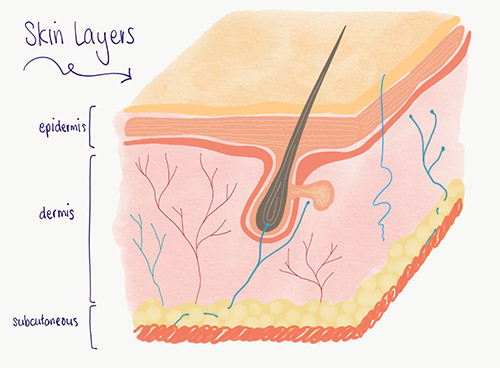
What Is Skin? | Science and Structure of Your Body's Largest Organ

Discovering the Wonders of Your Skin: Understanding Structure and Science
Have you ever wondered what your skin does and why it’s so vital for your overall well-being? Well, you’re not alone! Some of us are content with following a recommended skincare routine, while others, like myself, are curious to understand the WHY behind it all. Trust me when I say that having a basic understanding of how your skin works can be a game-changer in knowing how to properly care for it.
Picture this: your skin is like a remarkable shield, covering and safeguarding everything inside your body. Not only does it protect, but it also regulates body temperature and allows you to experience the sense of touch. Fascinating, isn’t it? Now, let’s dive into the magic of two main layers that make up your skin: the Epidermis and the Dermis.

Unveiling the Epidermis: Your First Line of Defense
The Epidermis is the outermost layer of your skin—the one you can touch, see, and apply products to. It serves a crucial purpose by acting as a protective barrier against infections and diseases. Now, here’s an interesting fact: on the topmost layer of your Epidermis lies the Acid Mantle, a thin film with an acidic pH. This special layer is a combination of water and oil that keeps your skin moisturized while combating harmful bacteria. It’s like your skin’s own superhero shield!
To keep your Acid Mantle strong, it’s essential to use the right products that won’t disrupt its delicate balance. A well-hydrated skin plays a pivotal role here. Hydrated skin cells are plump and fit together seamlessly, forming a firm barrier. On the other hand, dehydrated skin cells are brittle and curled, creating larger spaces between them that can allow irritants to sneak in. So, let’s quench that thirst and keep our skin hydrated, shall we? Not only does water support the Acid Mantle, but it also keeps those vital enzymes working hard and doing their job. Fun fact: Your Epidermis is constantly creating new skin cells that take about two weeks to reach the top and replace the old ones.
Delving into the Dermis: The Inner Support System
Now that we’ve understood the outer layer, let’s meet the powerhouse—the Dermis. This remarkable layer contains hair follicles, sweat glands, oil glands, nerve endings, blood vessels, and a whole lot more, including collagen and elastin. The blood vessels play a crucial role by delivering oxygen and essential nutrients to your skin cells, keeping them nourished and healthy. And you know what they say—healthy Dermis, healthy Epidermis, healthy skin!
Taking care of your skin involves nurturing it from both the inside and the outside. A balanced diet and a healthy lifestyle contribute to a radiant Dermis, which, in turn, reflects as glowing and functional skin. It’s all interconnected!
Embrace the Journey to Healthy Skin
Caring for your skin is a wonderful journey, and it’s worth every step you take. Understanding how your skin works empowers you to make informed decisions and choose the best care. So, let’s embark on this adventure together, shall we?
If you’re curious to learn more, we’ve got you covered! Dive into our articles below to discover how to care for your skin inside and out. Stay tuned for more skincare secrets, and remember, we’re here to guide you every step of the way!
Note: As we take care of our skin, let’s also remember to be kind and gentle with ourselves. Your skin deserves all the love in the world!
Skin Care from Within Glowing Hydrated Skin
